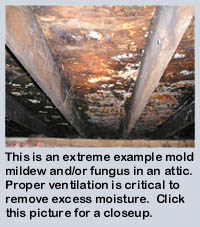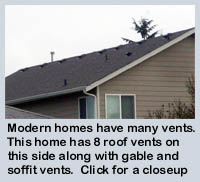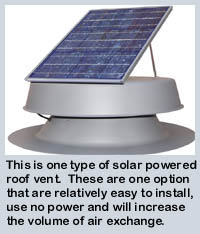 Why are vents important?
Why are vents important?
All homes should have attic ventilation, but most do not have enough. The temperature in the attic should be close to the outside air temperature but almost never is. I have personally recorded up to 145 degrees on a sunny summer day. Inadequate vents will contribute to wood decay, break down roofing prematurely, and will often lead to bio-growth (mold, mildew and fungus) Bio-growth over time may cause significant structural damage and potential health problems. If you look at a modern home, there are lots of roof vents. Modern building codes call for 1 square foot of ventilation for every 150 to 300 square feet of attic floor space, depending on vapor barrier and other construction factors.  That means for a typical 1500 sq foot home, there should be 5 to 10 square feet of ventilation. Almost no older homes have this and therefore their attics are hot, humid and are a ready breeding ground for bio-growth and structural pests.
That means for a typical 1500 sq foot home, there should be 5 to 10 square feet of ventilation. Almost no older homes have this and therefore their attics are hot, humid and are a ready breeding ground for bio-growth and structural pests.
Adding Vents
We are continually recommending better ventilation in attics, and if you are re-roofing a home, it is usually a good idea to add several. They are cheap, and easy to install when re roofing, and will make the roofing and framing last longer. Roofers will sometimes complain at the time because they often don't want to stop the roofing project long enough to cut new holes in the roof but insist on them anyway. As with all contractors, time is money and to set up a saw, cut the hole and properly weave in the vent takes a few minutes more. It is worth every penny!
 Powered vent options
Powered vent options
One excellent idea to add better ventilation for you attic is to consider a powered vent. Electric vents can move a lot more air and moisture from your home then passive ventilation. These come in several types, and most require professional installation. All powered vents will help reduce excess heat in the summer, potentially saving money in AC bills and making the home more comfortable. One of the newer and exciting energy saving alternatives are the solar powered vents. These have the advantages of the powered vents, but require no electricity from the home to run, and therefore no electrical permits to install. They can be thermostatically controlled, and will run when ever the sun is shinning. They are more expensive but since they use no power from the home, can be easier to install and they save electricity too. Read more about solar powered vent options here.

If you find this information useful, don't keep us a secret! List us on any of your favorite networking / bookmarking sites



